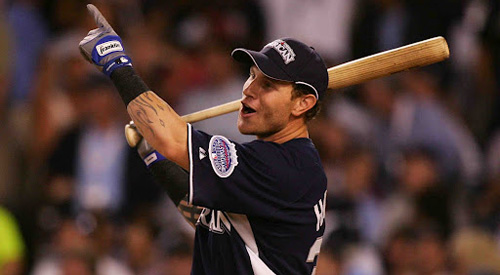
Making it count: Re-inventing the MLB All-Star Game
The Major League Baseball All-Star Game is often thought of as the best of the All-Star Games of any of the four major sports.
Now, let’s improve it.
Compare the lead-up to the MLB All-Star Game (with its Home Run Derby, mostly fun, the Futures Game, intriguing but largely ignored, and the Celebrity Game, entirely ignored) to the festive atmosphere of the Saturday night NHL Skills Competition or the NBA lineup at the 3-point shootout, point guard relay, and Slam Dunk Competition.
There’s no reason that Major League Baseball, a sport that values so many different skills, needs to constrain itself to just “quantity of home runs.” Imagine if a true baseball skills showcase in the spirit of the NHL was established for the night before the All-Star Game, adding to the Home Run Derby with the following:
* Crown the fastest player in the Major Leagues from home plate to first base.
* Send the top flamethrowers to the mound, give them each three pitches, and see who throws the hardest fastball in the Majors. (Repeat this competition with infielders, outfielders and catchers to see which position player has the strongest arm in MLB.)
* Set up a sharpshooting competition, setting up small targets at home plate to see which pitcher has the best control.
* Hold a long-toss contest, putting the strongest-armed outfielders at home plate and seeing who can throw a ball the farthest.
[php snippet=1]
These events shouldn’t be limited to the All-Stars. Bring in lightning-quick Reds minor leaguer Billy Hamilton and see if he’s faster than the Angels’ Mike Trout. Send up Bryce Harper to crush bombs alongside Adam Dunn in the Home Run Derby. Heck, add an extra element to the Home Run Derby, shortening it to one round and offering an extra monetary award to the player who hits the longest home run.
The resulting highlights could very well turn legendary.
While baseball may trail in All-Star Game extracurricular activities, it’s the Midsummer Classic itself where the national pastime takes the lead.
The fun of the All-Star Game in any sport, after all, is the sight of the top athletes in the world playing with and against each other: seeing Steven Stamkos, Alex Ovechkin and Sidney Crosby as teammates; seeing Derrick Rose and LeBron James team up against Kobe Bryant and Kevin Durant; seeing Justin Verlander take on Andrew McCutchen, Joey Votto and David Wright in succession.
This is where baseball seemingly owns the other All-Star Games. Where NFL Pro Bowlers move about freely around casual defenders, NBA All-Stars take uncontested jumpers and NHL All-Stars go end-to-end in a series of odd-man rushes, the National League lineup will receive the full complement of 100 MPH Verlander fastballs and filthy curves, followed by David Price sliders. Their American League counterparts, meanwhile, must avoid embarrassment against R.A. Dickey and Stephen Strasburg. No one lets up, not batter, not pitcher. It’s awesome.
It also ends around the third or fourth inning.
No one who praises the MLB All-Star Game seems to realize this fact: The best position players are (ideally) voted into the starting lineup and receive only two or three at-bats. The best starting pitchers are all used early. Consequently, from the fifth inning onward there’s a sea of lesser All-Stars determining the game’s fate. It’s enough to make a fan’s interest decline precipitously as the game moves along.
Worse, consider the situation entering the bottom of the ninth inning: Tight score, the top closer in the league coming in and a trio of uninspiring batters due to hit. This is when the All-Star Game should be at its most compelling, not grinding to an anticlimactic end.
At the end of a close NBA or NHL All-Star Game, the superstars lose all symptoms of prior nonchalance and the final few minutes are intense. Hatred of losing is woven into the DNA of any true competitor. When the game is decided, each league has its best players in place. Neither the NBA nor the NHL would let its All-Star Game end with lesser stars playing with the greater stars watched.
It goes against the core of a baseball purist, but the answer to keeping baseball’s Midsummer Classic exciting in the ninth inning is relatively simple: Change the rules and allow players to be reinserted into the MLB All-Star Game in the ninth inning. Imagine Jonathan Papelbon on the hill, one out away from finishing off the American League, then Josh Hamilton stepping up as a pinch-hitter. Whether you’re a purist or not, admit it – you would watch that ninth inning on edge. The game’s on the line and it’s the best against the best. You can’t top that.
There’s the smaller complaint each year against the decree that each team must have a minimum of one All-Star, but that’s another easy fix. Leading up to the game, each league’s manager carefully plans out the sequence of substitution for pitchers and players. Publicize that information. Let fanbases and local media know exactly when they can look forward to seeing their favorites enter. (Hey, Rangers fans. Yu Darvish is pitching the third inning. Simple.)
The All-Star Game is an exhibition that exists for four entities: 1) Major League Baseball, 2) the sponsors, 3) the players and 4) the fans. As long as the event is making money and gaining positive attention, both Major League Baseball and the sponsors are appeased. Showcase the jaw-dropping talents of the league leading up to a compelling game, and the players and fans will be equally pleased.
We won’t even need to worry about “This time it counts.”
[php snippet=1]

